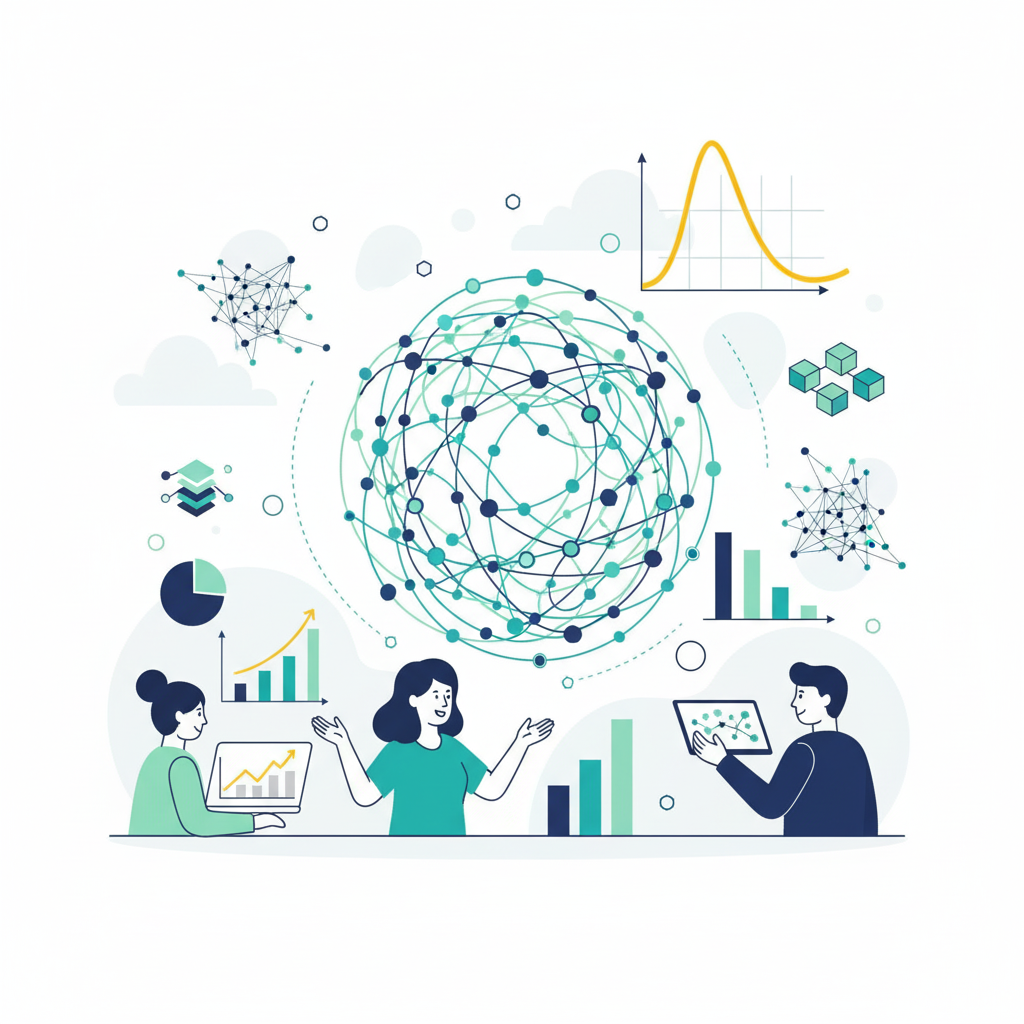Platform businesses don’t play by the same rules as regular products. Not even close.
Traditional products? Linear economics. Sell to 100 customers, make 100 units of revenue. Platforms? They compound value quadratically or exponentially. That’s the difference between grinding for growth and watching it accelerate on its own.
This article is part of our comprehensive guide to technology power laws, where we explore the mathematical forces shaping modern technology markets.
Three mathematical laws explain this: Sarnoff’s Law (N), Metcalfe’s Law (N²), and Reed’s Law (2^N). Understanding which one applies to your platform is the difference between capturing 70% of your market or getting crushed by someone who understands the math better.
Here’s why this matters: the difference between N and N² scaling determines whether a 10% user advantage gives you 20% more value or complete market dominance.
What is Sarnoff’s Law and why is it the baseline for network value?
David Sarnoff led RCA and created NBC from 1919 to 1970. He noticed his network’s value grew in direct proportion to its size. Add another radio, add one unit of value. Simple. This became Sarnoff’s Law: Value = N.
Sarnoff’s observation worked for broadcast networks. When you’re running a hub-and-spoke system—one broadcaster sending to passive receivers—each new radio doesn’t do anything for the other radios. The broadcaster wins by reaching more people, but listener 1,000 doesn’t care when listener 1,001 tunes in.
This is the weakest form of network scaling. No user-to-user value. Ten radios = 10 units of value, 100 radios = 100 units of value.
Sarnoff’s Law underestimated value for networks that allow interaction between nodes, but it’s still the baseline. Real network effects require growth patterns that beat linear scaling.
Podcasting still operates on Sarnoff’s Law. Streaming content platforms where users don’t interact follow the same pattern. These aren’t bad businesses. They just don’t create the compounding defensibility that Metcalfe and Reed dynamics generate.
What is Metcalfe’s Law and how does it calculate communication network value?
Robert Metcalfe invented Ethernet and needed to explain why communication networks were different from broadcast systems. His answer: network value grows proportional to the square of users. Value = N².
The maths come from connection density. In a network where any user can connect with any other user, you create N(N-1)/2 possible connections. For large networks, this approximates to N². So 10 users create roughly 100 units of value. Scale to 100 users and you get 10,000 units of value. That’s 100 times the value from a 10x increase in users.
This is where real network effects kick in. Double your users, quadruple your value. A competitor with half your network size doesn’t have half your value—they have one-quarter.
Metcalfe’s Law has been validated empirically. Facebook and Tencent data confirmed the N² scaling pattern. Metcalfe himself used Facebook’s growth data to prove it.
Back in 1908, AT&T’s Theodore Vail wrote that a telephone without a connection at the other end is useless—its value depends entirely on connections to other telephones and increases with the number of those connections. That’s the first time anyone explicitly recognised what became Metcalfe’s Law.
What is Reed’s Law and when does exponential value growth apply?
David P. Reed from MIT published Reed’s Law in 1999 with an even more aggressive claim: networks that support group formation scale exponentially. Value = 2^N.
The maths come from combinatorics. With N users, you can form 2^N possible groups. Ten users can form 1,024 possible groups (2¹⁰). Add just one more person and you jump to 2,048 groups—double the value from a single additional user.
Reed’s Law only works if your platform has specific features. You need to support clusters, sub-communities, and group structures. Facebook Groups, LinkedIn Communities, Slack channels—these features enable Reed dynamics. Without them, you’re stuck at Metcalfe scaling.
Here’s the practical implication: adding group features to a communication network can shift your growth curve from N² to 2^N. But Reed’s exponential growth only applies after you reach sufficient scale of group-forming activity. Early-stage platforms still operate under Metcalfe dynamics.
So you’ve got three mathematical laws that describe how network value scales. But the type of network effect matters too.
How do direct network effects differ from indirect network effects?
Direct network effects create value through user-to-user interaction. Each new user makes the product more valuable for existing users because they can now interact with that person. WhatsApp, Facebook, telephone networks—they all work this way.
Indirect network effects work differently. Value increases through complementary products or services, not through direct interaction. Windows demonstrates this clearly: more Windows users don’t benefit other users through communication. Instead, more users attract more developers, who create more applications, which makes Windows more valuable to everyone.
Two-sided marketplaces operate on indirect effects. Take eBay: adding another seller doesn’t help existing sellers directly. It just creates more competition. But more inventory makes eBay more attractive to buyers, which increases the total customer pool, which ultimately benefits all sellers.
Direct effects have a vulnerability: multi-tenanting. When users can easily participate in competing networks at the same time, your network effects weaken. Drivers use both Uber and Lyft, sellers list on both eBay and Etsy. Low switching costs between networks reduce lock-in.
Indirect effects create stronger defensibility once you establish them because you’re locking in both sides at once. But getting there requires solving the chicken-and-egg problem first.
Which mathematical law applies to which type of platform?
Broadcast platforms follow Sarnoff’s Law (N). If users consume content but don’t interact with each other, you’re looking at linear growth. Podcasting, streaming content without social features, traditional media distribution—all operate under Sarnoff dynamics.
Communication networks follow Metcalfe’s Law (N²). Telephone networks were the original example. Modern messaging apps like WhatsApp and Telegram—without group features—still scale according to N².
Group-forming networks follow Reed’s Law (2^N). Facebook with Groups, LinkedIn with Communities, Slack with channels—these platforms support cluster formation, which enables exponential scaling.
Two-sided marketplaces need modified models. eBay, Uber, Airbnb don’t follow pure N² or 2^N scaling because value depends on balanced growth between supply and demand sides, not just total user count.
Most modern platforms combine multiple effect types. Facebook demonstrates Metcalfe dynamics through personal connections, Reed dynamics through Groups, and indirect effects through its advertising marketplace.
The practical question: which laws apply to which features of your platform? Build your growth model around the dominant effect for your core value proposition.
Why do platforms capture exponentially more value than regular products?
Traditional products scale revenue linearly. Sell to 100 customers, generate 100 units of revenue. Double your customer base, double your revenue.
Platforms break this pattern through compounding network effects. With N² or 2^N growth, your value increases faster than your user base. A platform with 100 users generates 10,000 value units under Metcalfe’s Law. A competitor with 50 users generates only 2,500 units. You have 2x the users but 4x the value.
This gap creates winner-take-all dynamics. The larger platform doesn’t just have a bigger network—it has a disproportionately more valuable network. Every new user you add increases your advantage over smaller competitors in a compounding cycle. These network effects combine with economies of scale to create the mathematical forces driving market concentration across technology markets, explaining how power laws create market concentration.
Beyond pure network effects, platforms layer on additional defensibility. Switching costs accumulate as users build connection graphs, create content, and develop learned workflows. Data network effects emerge as larger platforms collect more user data, improving product quality in a reinforcing cycle.
The result is what Warren Buffett calls a moat—a structural barrier against competition. Product features can be copied. Network size advantages become increasingly difficult to overcome as the value gap widens.
How is network value calculated in practice with real numbers?
The pure maths of Metcalfe’s Law are simple: V = N². For 1 billion users, that’s 1 × 10¹⁸ potential connections. But what’s each connection worth?
Practical valuation requires estimating value per connection. You can approach this through revenue per user, engagement metrics, or willingness-to-pay studies.
The flaw in pure N² is assuming all connections have equal value. They don’t. Metcalfe himself observed that affinity declines with network size. You might have 1,000 Facebook connections, but research shows people actively engage with only 150-200 of them.
This cognitive limit is called Dunbar’s number—approximately 150 meaningful relationships a person can maintain. Andrew Odlyzko used this observation to critique pure N² scaling, proposing n log(n) as more accurate for large networks.
Financial markets don’t directly calculate N² anyway. They use proxies: user count, engagement metrics, revenue per user, growth rates. Platform valuations emerge from these observable metrics combined with comparable company analysis.
For Reed’s Law, the 2^N calculation creates impossible numbers. The practical interpretation: active group count matters more than theoretical maximum.
Critical mass thresholds vary by platform type. Consumer products typically need 15-25% of their target market. For local marketplaces like Uber, critical mass is city-specific—hundreds to thousands of users per geographic market. Understanding critical mass thresholds is essential to avoid platform failure.
Track active connections, actual group participation, and real engagement patterns. These observable metrics predict value better than pure mathematical formulas.
What are the strategic implications of network effects for platform competition?
First-mover advantage compounds in network effect markets. An early network lead grows through N² or 2^N dynamics, making it progressively harder for later entrants to compete.
This creates natural monopolies in many platform categories. Winner-take-all doesn’t mean only one company exists, but that one company captures the majority of available profits.
Timing matters. Enter before the market is ready and you waste resources before demand exists. Enter after an incumbent reaches sufficient scale and you’re fighting uphill. The optimal window: emerging market, no clear winner yet.
Multi-tenanting weakens network effects significantly. When users can participate in competing networks simultaneously, switching costs drop. The solution: design features that create stronger lock-in, particularly on the supply side.
Niche positioning offers an alternative to direct competition. LinkedIn focused on professional identity while Facebook owned personal identity. Both built powerful networks in their respective niches.
Interoperability represents a threat to platform power. If networks become interoperable—like email—individual platform network effects diminish. Platform businesses fight interoperability for this reason. This dynamic helps explain network effects in standards adoption.
Growth tactics matter more for platforms than products. Bootstrapping strategies include single-player mode (providing value independent of network effects initially), subsidisation (paying to acquire supply or demand), and white-hot centre focus (concentrating on your highest-engagement user segment first).
Real identity requirements strengthen network effects. LinkedIn and Facebook use real names, creating stronger lock-in than pseudonymous platforms.
When do network effects become a defensible competitive moat?
Critical mass is the threshold where your value proposition becomes self-sustaining. Before this point, you’re subsidising growth and fighting churn. After it, organic growth accelerates.
Quantitative indicators include: growth rate exceeding churn rate without subsidies, organic growth dominating paid acquisition, and increasing user lifetime value.
Competitive resilience provides another test. The Facebook versus Google+ case demonstrates this clearly. Google+ launched with better features and Google’s distribution muscle. It failed anyway because Facebook users had accumulated years of photos, posts, and connections. The switching cost was too high.
This demonstrates how network effects create defensibility.
But network effects can turn negative at extreme scale. Network congestion occurs when infrastructure can’t scale with users, degrading experience. Network pollution happens when new users reduce quality through spam or low-quality content.
The strongest defensibility combines multiple moat types. Network effects alone can be overcome with sufficient capital. But network effects plus switching costs plus data effects creates substantial barriers to entry.
FAQ Section
What’s the difference between N² and 2^N in practical terms?
Metcalfe’s Law (N²) means doubling users quadruples value. Reed’s Law (2^N) means adding one user doubles potential value. For 10 users, N² = 100 while 2^N = 1,024. For 20 users, N² = 400 (4x increase) while 2^N = 1,048,576 (1,000x increase). Reed’s exponential growth only applies when platforms have both group features and enough user density within those groups to activate Reed’s Law dynamics.
Does Metcalfe’s Law apply to all social networks?
No. Pure communication networks without group features follow Metcalfe’s Law (N²), while networks supporting groups follow Reed’s Law (2^N). WhatsApp without groups = Metcalfe. Facebook with Groups = Reed. The mathematical law depends on product features enabling cluster formation.
How many users constitute critical mass for network effects?
The threshold varies significantly by platform type and total addressable market. Consumer products typically need 15-25% of their target market. For local marketplaces like Uber, the threshold is city-specific—you need hundreds to thousands of users per geographic market. For global platforms like Facebook, millions were required. You’ve reached the threshold when organic growth exceeds churn without subsidies.
Can network effects work in B2B SaaS products?
Yes. Salesforce demonstrates platform network effects through AppExchange and its consultant ecosystem. Slack shows communication network effects within organisations. Protocol adoption like Ethereum creates network effects through developer ecosystem lock-in. B2B network effects build more slowly but create stronger switching costs.
What is the biggest threat to network effects defensibility?
Multi-tenanting—users participating in multiple networks at the same time. When switching costs are low and users can easily use competing platforms in parallel, network effects diminish. Freelancers maintain profiles on both Upwork and Fiverr. Professionals network on both LinkedIn and Xing in different regions. This behaviour reduces lock-in and makes it easier for users to switch their primary platform.
Why did Google+ fail despite having better features than Facebook?
Network effects trumped product quality. Facebook users had accumulated years of photos, posts, and connections. Migrating to Google+ meant abandoning this accumulated value and convincing all friends to switch at the same time. Google+ offered superior features but couldn’t overcome Facebook’s N² network advantage and switching costs.
Do network effects ever become negative?
Yes. Network congestion occurs when infrastructure can’t scale with users. Network pollution happens when new users reduce quality through spam or low-quality content. Facebook has faced criticism for news feed pollution. Twitter faces harassment and misinformation challenges.
What’s the relationship between Dunbar’s number and Metcalfe’s Law?
Dunbar’s number (approximately 150 meaningful relationships) suggests cognitive limits on connection value. Andrew Odlyzko critiqued Metcalfe’s Law using this observation, proposing n log(n) as more accurate for large networks. While Facebook users may have 1,000 connections, they actively engage with only 150-200.
How do I estimate network value for my own platform?
First, identify which mathematical law applies: broadcast = N, communication = N², group-forming = 2^N. Second, count active users, not just registered accounts. Third, estimate value per connection using engagement metrics or revenue per user. Fourth, calculate using the appropriate formula. Fifth, validate against market comparables.
Can network effects be built intentionally or do they emerge organically?
Network effects must be designed into product architecture, but growth combines intention and organic dynamics. Product features determine which law applies. Bootstrapping strategies like single-player mode and subsidisation intentionally drive toward critical mass. Post-critical mass growth becomes increasingly organic.
What role does timing play in network effect competition?
Timing determines outcomes. Entering before the market is ready means wasting resources. Entering after an incumbent reaches sufficient scale means fighting uphill against N² or 2^N advantages. Optimal timing: enter when the market is emerging but before a clear winner. LinkedIn timed professional networking well. Later entrants struggled despite regional advantages.
How do indirect network effects differ strategically from direct effects?
Direct effects (user-to-user value) build faster and create immediate value, but face multi-tenanting risk. Indirect effects (cross-side value in marketplaces) build slower due to the chicken-and-egg problem but create stronger defensibility through simultaneous lock-in of both sides. Strategy: use single-player mode to solve chicken-and-egg, then leverage cross-side effects for defensibility.
For a complete overview of how network effects interact with other power laws shaping technology markets, see our comprehensive guide to technology power laws and platform dominance.












